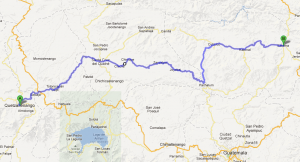Our van has been a stalwart, faithful conveyance. For the most part. It’s taken us along highways, byways and barely-there-ways. It does have its share of quirks and idiosyncrasies: early on, the driver’s window stopped working and needed to be closed by hand, then it worked again, then it didn’t, now it does; the hydraulic lifters that keep the upper tail-gate open have ceased to function, and we now have to hold the gate open by hand, or let it drop on our heads; the brakes squeak mercilessly when used lightly at low speeds; on a long downhill stretch into Panajachel, they got progressively mushier, and eventually all but failed, only to come back a few minutes later and have worked fine ever since; and so on.
But the engine, transmission, steering and such have been rock solid (knocking on wood, here) and performed admirably. Last week, we left Quetzaltenango (a/k/a Xela) heading in the general direction of Semuc Champey, enjoying the weather and the scenery. The nice, smooth two-lane blacktop wound its way into the mountains, and gradually became less smooth, and less nice, and rather narrower. Eventually, it turned into a road of dirt and rocks and holes and lumps, barely more than a single lane wide. My navigator assured me that Google Maps showed this route as a major road. The terrain beneath the tires did not agree, and continued in this dissent for many miles. It was sufficiently rough that the speedometer stayed mostly in the 10-15 MPH range.
But Rocinante kept right on chugging along. Stuck in first gear for long stretches, it handled the rough terrain with aplomb. Its ground clearance is nothing special, and its suspension is more suited to North American freeways than to Centro American mountains, but with a little care in the rough patches, we avoided scraping bottom. Mostly.
We progressed eastward, with an eye toward Pachalum, where we would change to what certainly must be a major road, the CA5, the main road leading north out of Guatemala City. And sure enough, just before Pachalum, the road got better, wider and eventually paved. And once out of the town, on the CA5, it got narrower, and worse, and completely unpaved once more. But the van motored onward.
Until it didn’t. Going up and up a rather long, bouncy, dusty stretch, the engine suddenly stalled. And as in most modern American-made automobiles, the power steering and power brakes went with it. I could still brake and steer, but it suddenly required lot more effort. Rather stimulating. And there was nothing for it but to stop, shift into Park, restart the engine, throw it back into first, and continue. A few minutes later, it stalled again. Rinse and repeat.
We were at a loss to explain this sudden behavior. In Mérida, the van’s seller had mentioned something about the electric fuel pump overheating and shutting down until it had cooled again, but he’d also told us that the way to avoid this was to keep the gas tank full, advice we had been following faithfully. And the problem did seem like an intermittent fuel-pump failure, but the water temperature was reasonable, and I hadn’t been pushing the engine very hard at all. Still it kept stalling. So, after many stalls and restarts, we finally parked for a few minutes in the shade and let everything cool down. And eventually, we crested the long hill we’d been climbing, and cruised gently into Rabinal. From there, the road into Salamá was paved and smooth, with many downhill stretches.
We spent the night in Salamá, at a small hotel that kept a large cage in its courtyard, containing several squirrels, and a very grumpy paca, who growled at us. The next morning, we continued into Cobán, and the engine didn’t stall again. Nor has it since.



Pingback: La Esperanza to Perquín | Wandering Homestead
Pingback: Further on down the road | Wandering Homestead
So that’s what was going on when I impulsively skyped you all and Elizabeth mumbled, “um, this isn’t a very good time really.”
Nothing like an exciting vehicle to add pizzazz to your journey. Glad all’s
well as you continue.